Tips for Disabled Dog Owners in Nottingham
Training a dog as a disabled dog owner presents unique challenges and opportunities. The key is to find accessible training methods and resources that suit both the owner's and the dog's needs. Here are some strategies and resources for disabled dog owners:
Training Strategies for Disabled Dog Owners
1. **Adapted Training Methods**:
- **Remote Training Tools**: Use treat dispensers, or clickers to reinforce commands without needing to move frequently.
- **Voice Commands and Apps**: Utilize voice-activated apps to control training devices or play pre-recorded commands.
- **Assistance from Others**: Seek help from friends, family, or professional trainers for physically demanding training tasks.
2. **Accessible Training Equipment**:
- **Hands-Free Leashes**: Leashes that can be worn around the waist or shoulders to free up hands.
- **Adaptive Training Gear**: Custom harnesses, leashes, and collars designed for easier handling.
3. **Professional Support**:
- **Certified Trainers**: Work with local trainers who have experience in adaptive training techniques for both dogs and owners and can provide personalized support.
Practical Tips
1. **Set Realistic Goals**: Understand the limitations and set achievable training goals for both you and your dog.
2. **Consistency is Key**: Maintain a regular training schedule to reinforce learning and behavior.
3. **Celebrate Small Wins**: Acknowledge and reward small milestones to keep motivation high for both you and your dog.
4. **Be Patient and Flexible**: Training may take longer and require adjustments; patience and flexibility are essential.
By leveraging these strategies and resources, disabled dog owners can successfully train their dogs while accommodating their unique needs and circumstances.
